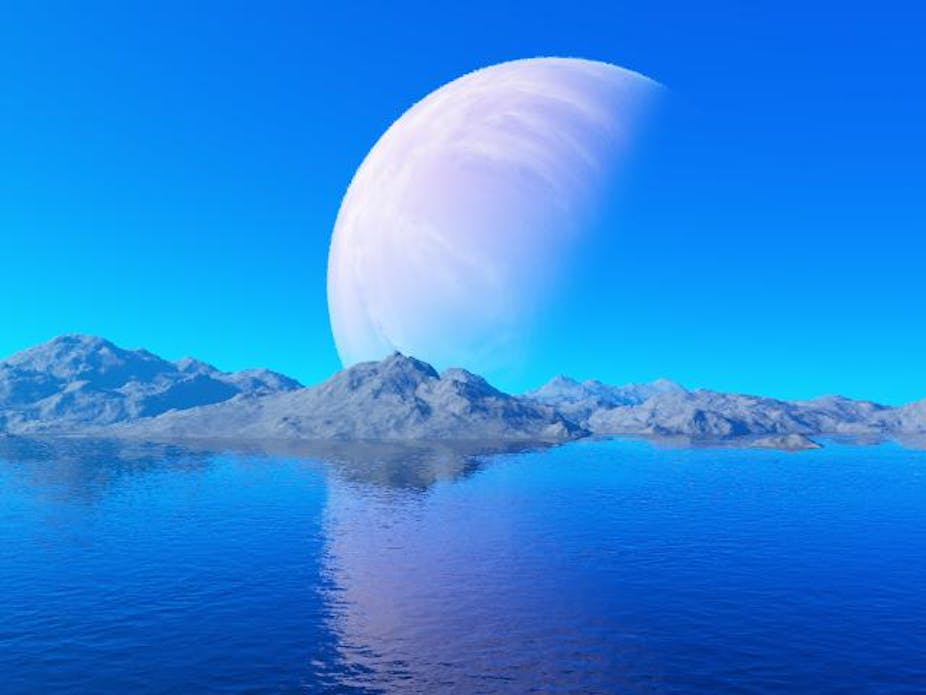In the Star Wars universe, everyone’s favourite furry aliens, the Ewoks, famously lived on the “forest moon of Endor”. In scientific terms, the Ewok’s home world would be referred to as an exomoon, which is simply a moon that orbits an exoplanet – any planet that orbits a star other than our sun.
Although more than 1,000 exoplanets have been discovered since the first one was found in 1995, only a handful of those are thought to be habitable, at least by life as we know it. New research shows that exomoons, too, could provide habitable environments. Although we are yet to find exomoons, we have good reasons to believe that there should be many, even more than exoplanets.
Goldilocks zone
Perhaps the most habitable planet found to date is the recently announced Kepler-186f. This is one of five exoplanets discovered by NASA’s Kepler satellite, all orbiting a small, faint, red dwarf star, 500 light years away in the constellation of Cygnus.
Kepler-186f is an Earth-sized planet that orbits its star in only 130 days and is about as distant from its star as Mercury is from the Sun. But, because the red dwarf is much dimmer than the Sun, Kepler-186f receives only about one-third of the energy that the Earth does. As a result, Kepler-186f lies at the outer edge of its star’s “habitable zone”. This is the hypothetical region of space surrounding a star in which liquid water may conceivably exist on the surface of any exoplanets.
In our own solar system, Venus lies too close to the Sun and is too hot. Mars lies too far from the Sun and is too cold. But Earth, of course, lies within the critical “Goldilocks zone”, where the temperature is just right.
Simply residing in the habitable zone, though, is no guarantee that an exoplanet has water oceans. The climate of a planet is much more complicated than we can capture with a simple calculation based on the distance of a planet from a star. We know that Mars probably had running water on its surface in the past, but now it is a frozen desert. Earth, meanwhile, was probably in a completely frozen “snowball” state about 650m years ago.

Even leaving aside questions of climate, not all exoplanets have a surface on which liquid water could exist. Many of the exoplanets found in the past 20 years are massive, Jupiter-sized planets. This is not surprising, as bigger planets are easier to find (even if they are not the most numerous). But a Jupiter-sized exoplanet in the habitable zone of a star is unlikely to have liquid water, much less prove a suitable habitat for life as we know it.
Jupiter has an outer atmosphere of gaseous and liquid hydrogen overlaying a metallic hydrogen envelope that extends for thousands of kilometres. Any rocky surface is confined to a core buried under millions of atmospheres of pressure.
But if a Jupiter-like exoplanet orbits within a star’s habitable zone, it begs the question: might that exoplanet host habitable moons, like the Ewok’s home? Jupiter has Europa, which is suspected to have liquid water buried under an ice crust, and Saturn has Enceladus, which definitely has water hidden underneath its coat of hydrocarbon ices. So Earth-like exomoons are certainly not out of the question.
Finding the right temperature
Recent research by Duncan Forgan and Vergil Yotov at the University of Edinburgh highlights the various factors that may make an exomoon more or less habitable. They investigate how the climate of an exomoon will be affected by tidal stresses which provide a source of internal heating for the exomoon as it is stretched and deformed by the gravitational pull of its planet. They also investigated how light reflected from the exoplanet, and eclipses by the exoplanet, can also subtly alter the exomoon’s climate.
The researchers lump theoretical exomoons into a number of classifications: “habitable”, “hot”, “snowball” or “transient”. Those in the first class have more than 10% of their surface at a temperature between the freezing and boiling points of water, with only a small fluctuation around the average temperature value.
Those in the second class have average temperatures above 100°C at all times, whereas those in the third class are permanently frozen – in both cases less than 10% of the surface is habitable. Exomoons in the fourth, transient class are on average habitable, but the amount of habitable surface area varies widely with time. Overall, this research shows that exomoon climates are rather more complex than previous research has supposed.
As yet, no exomoons have been discovered, but there are various techniques proposed for finding them. One way is by studying the effects that an exomoon will have on the exoplanet it is orbiting – their gravitational connection means there will be a to-and-fro tugging between them. This will cause variations in the times at which the planet transits in front of its star and in the durations of these transits, which we are able to measure.
These time variations will only be a few seconds at most, so very accurate measurements of the transits must be made in order to reveal the exomoon’s presence. If variations are detected then, in principle, both the mass and orbit of the exomoon may be calculated from the measurements.
It surely is only a matter of time before the first exomoon is discovered and the probability of finding one in the habitable zone of a star is reasonably high. We may not find any Ewoks, but habitable exomoons may indeed offer the best prospect for hosting alien life.

